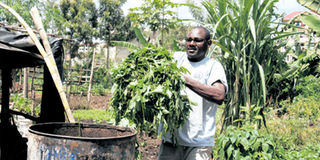All about using plants to curb pests on farm and in the store

Robert Ngugi prepares fertiliser from tithonia leaves in his farm in Wendani, Nairobi. The plant is also used to control pests. FILE PHOTO | NATION MEDIA GROUP
What you need to know:
- Organic pest control and management comes in three ways. The first one involves the use of natural plant materials to control pests. Farmers can plant pest repellents such as stinging nettle, Russian comfrey, tithonia and leucaena together with their crops.
- Application of plant solutions made from pyrethrum, Mexican marigold, hot pepper or chillies, ordinary wood ash, onions, garlic and coriander in the field also helps to repel several pests.
Organic farming combines traditional African knowledge and latest science innovations to benefit the environment and promote a healthy lifestyle.
The techniques used in organic agriculture rely on crop rotation, green manure, compost and biological pest control. This farming method strictly restricts the usage of manufactured fertilisers and chemicals.
Pests such as insects, nematodes and rodents cause losses to farmers by damaging crops in the field or harvested produce in the store.
Organic pest control and management comes in three ways. The first one involves the use of natural plant materials to control pests. Farmers can plant pest repellents such as stinging nettle, Russian comfrey, tithonia and leucaena together with their crops.
Application of plant solutions made from pyrethrum, Mexican marigold, hot pepper or chillies, ordinary wood ash, onions, garlic and coriander in the field also helps to repel several pests.
Plants have also been used effectively to control storage pests. In this method, dried Mexican marigold (Tagetes minuta), tephrosia (Tephrosia vogelli) or chilli pepper pods are crushed and mixed with ashes or dry dung to deter pests. Addition of the mixture to cereals like maize, sorghum, beans and green grams is used to repel or kill khapra beetles, grain moths, maize and rice weevils, and bean bruchids.
Further, the dried and crushed leaves of thorn apple and tick berry (Lantana camara) can be mixed with stored pods or grain to repel storage pests.
Lantana is well-known to be effective for controlling potato moth during storage. Produce treated with Persian lilac or Neem (Azedarach indica) can last for up to two years without any pest attack.
Care should be taken by the farmer to wash hands thoroughly after treatment. Rubber gloves are recommended when applying plant materials to produce.
Similarly, clean the produce thoroughly before cooking. Grains for flour should also be thoroughly cleaned and re-dried prior to milling.
Farmers can also encourage other living organisms that attack pests to live on their farms as a control measure. Examples include parasitic wasps, praying mantis, dragon flies, ground beetles and spiders. Parasitic wasps lay their eggs, feed and grow inside the larvae of caterpillars killing them.
Growing plants with flowers like dill and fennel provide good environment for predators. Ladybirds are very efficient predators of aphids. Chameleons and lizards are insect eaters and help in keeping garden pests under control.
Lastly, cultural pest control involves use of compost and green manuring to improve soil fertility and support healthy crops. A crop which is weak is easily attacked by pests and diseases. Suitable soil cultivation methods like conservation tillage can be used to control pests depending on the area and season.
When digging the soil, eggs and larvae are brought to the surface where they are burned by the sun or picked by birds. Early weeding to control pests is also advisable.
Some weeds act as alternative hosts to crop pests. Field cleanliness interferes with life-cycle of pests by removing the harvested crop remains and composting them for use as manure. The premature fallen fruits, which might be infested with larvae should be removed to prevent growth of future pest populations.
Crop rotation should be used by farmers in pest control as it separates an individual pest in time and space from its host crop.
The interruption of the life-cycle by introducing a non-host crop reduces the spread of the pests in the following seasons. Farmers are encouraged to practice proper spacing, timely planting, use of trap crops, crop diversification to culturally control pests.
Ms Makau works in the Department of Dairy, Food Science and Technology, Egerton University.



